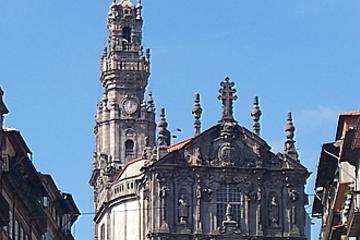
One of the symbols of Porto is the Torre dos Clerigos, the bell tower adjoining the Clerigos Church, a baroque church built between 1732 and 1750. The church was one of the first Baroque churches in Portugal. Its Baroque adornments reflect the city’s seaside way of life, as its façade is carved with shells and garlands.
More iconic than the church however, is its bell tower. Standing at 75 m (245 ft) high, the tower offers an amazing, panoramic view of the city, the Duoro River and the Atlantic coast. Completed in 1763, this granite tower is based upon a Roman Baroque design scheme coupled with an unmistakably Tuscan bell tower design; visitors familiar with Italian architecture will be delighted to see a decidedly Roman Baroque masterpiece towering over a Portuguese port. Once you’ve ascended the 225 steps and reached the top of the sixth floor, the Torre dos Clerigos, you’ll be able to see the whole city.
Inside the church, you’ll enter into the Roman-influenced elliptic nave; in the main chapel, the altarpiece is a beautiful masterwork of polychrome marble, carved by famed sculptor Manuel dos Santos Porto, whose work can be found throughout Porto and Vila Real de Santo António in the Algarve.
The Igreja dos Clérigos, as it is known in Portuguese, was designed by an Italian architect and painter named Nicolau Nasoni, at the behest of the Brotherhood of the Clergy, for whom the church is named. Following his death in 1773, Nasoni was entombed in the church’s crypt, per his personal request.